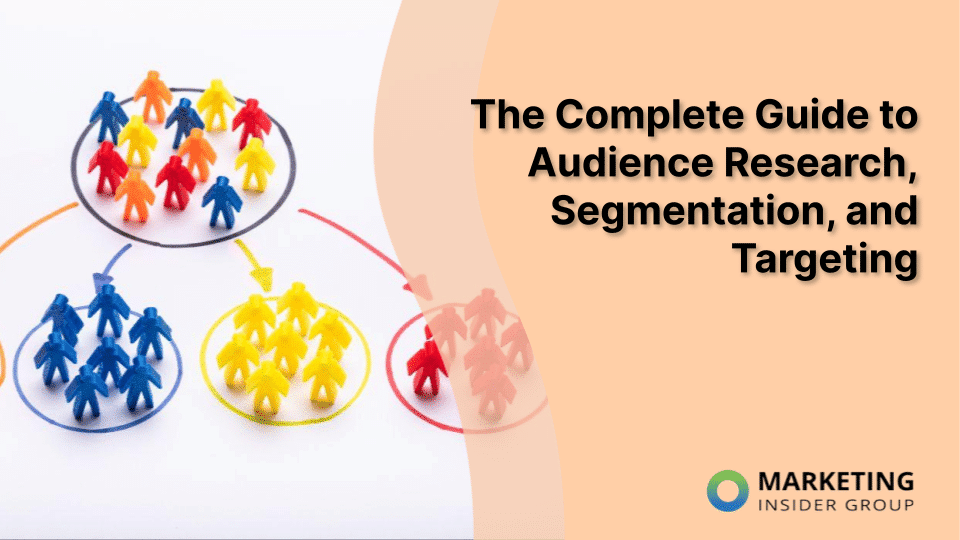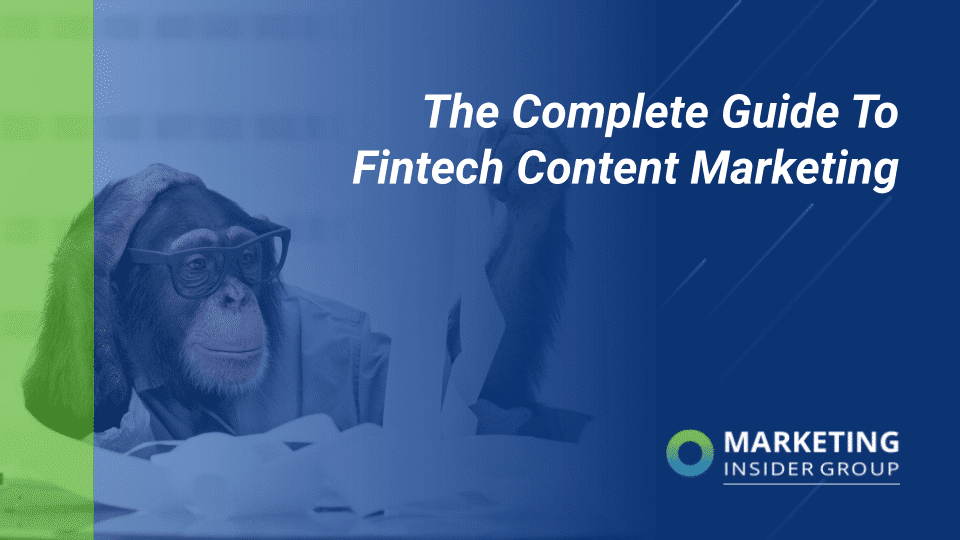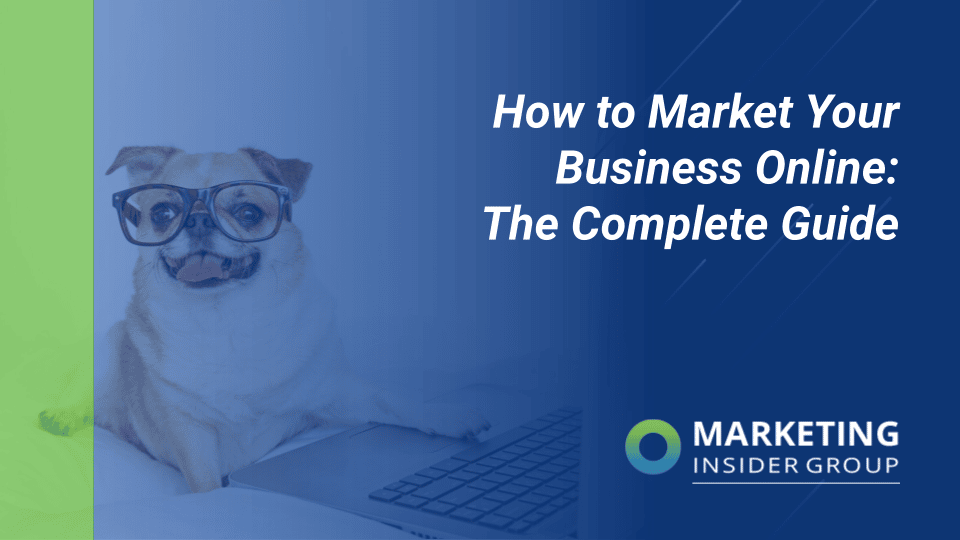
How to Market Your Business Online: The Complete Guide
Marketing online has become essential for every kind of business — even those that operate mostly offline. Consumers are increasingly turning to online sources for brand discovery and to choose solutions.
If you’re wondering how to market your business online or to refine your existing strategy, you’ve come to the right place. In this guide, we will cover:
- Important facts and figures about online marketing
- Online marketing channels
- Types of online marketing content
- 7 steps to launching an online marketing strategy
Let’s dive in!
Quick Takeaways
- Three-quarters of people say they are always on the lookout for brands and products online.
- Even consumers who buy offline often conduct brand discovery online.
- Your company website, email, search engines, and social media are four of the most important online marketing channels.
- Companies create a variety of content to market their businesses online, including blog articles, ads, email, and video.
- The first step to building an online marketing strategy should always be defining your target audience.
- Strategies have the most success when they have a documented execution plan.
Online Marketing 101: What does it mean to market your business online (and why do you need to do it?)
Online marketing (also called digital marketing) is the process of building your brand’s online presence to attract new customers and grow your business. It’s become essential for every kind of brand — even those that operate primarily from brick-and-mortar locations.
Why? Because consumers are going to the internet when they need to make a purchase.
The average adult now spends 6+ hours online every day, and 3 out of 4 say they are always on the lookout for brands and products relevant to them. A whopping total of 263 million consumers are shopping online as of last year — 80% of the population — and more than half report that they prefer it over offline shopping. Even when people intend to make their purchase offline, they often go online first to find it.
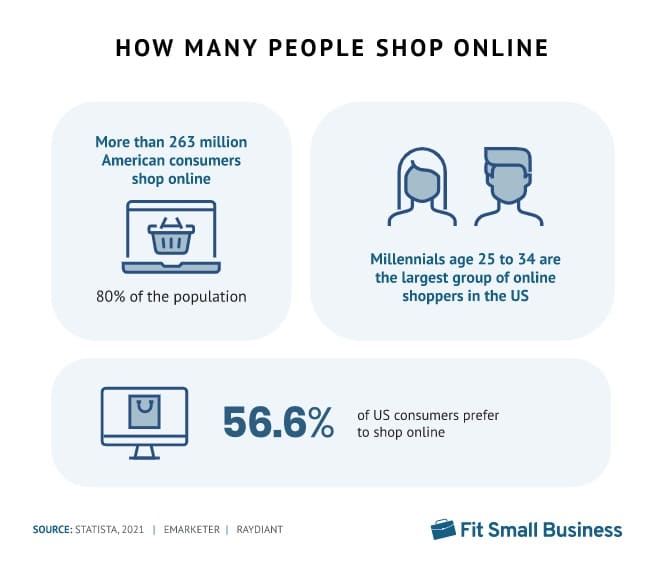
Image Source: Fit Small Business
The takeaway: marketing your business online isn’t just an option, it’s become an imperative.
In the next few sections, we’ll walk through the online channels you can use to market your business, the types of online marketing content you can produce, and 9 actionable steps to get your online marketing strategy up and running.
Online Marketing Channels
Marketing channels are the means through which brands communicate with their audiences. In the case of online marketing, top channels include company websites, email, search engines, and social media. Let’s dive into each of these 4 channels in more detail to find out how you can use them to successfully market your businesses online.
Company Website
Your company website is like your online storefront. It often serves as your first impression to potential customers. It’s where you showcase everything about your brand: “about” information, products and services, content and more. It’s where consumers know to go when they want to know more about you.
If you’re just beginning to build your online presence, creating a company website is the first step to take. A quality website builds credibility and shows consumers you’re a legitimate business. It’s your online home base — the place where you’ll drive online traffic and convert web visitors to leads.
Read more: The Only Website Launch Checklist You’ll Ever Need
Email is one of the oldest forms of online marketing, but it’s still most preferred by consumers. Despite increasingly full inboxes — the average person receives 100+ emails every day), — 68% of consumers say they still prefer email over all other forms of brand communication.
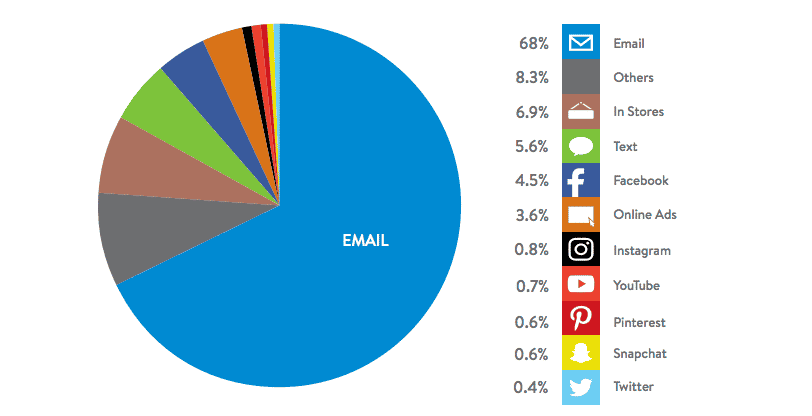
Image Source: MarketingProfs
Email is an attractive marketing channel for brands, too, because it provides a direct line of communication to their most engaged audiences. Building an email list and sharing high-value content with subscribers is a core activity in most online marketing strategies.
Read more: 7 Keys to Successful Email Marketing
Search Engines
Search marketing is perhaps the most critical part of your online marketing strategy. Today, it is estimated that around 93% of all online experiences begin with search. People use search engines to find answers to every kind of question, problem, or need that they have — including finding new products and brands.
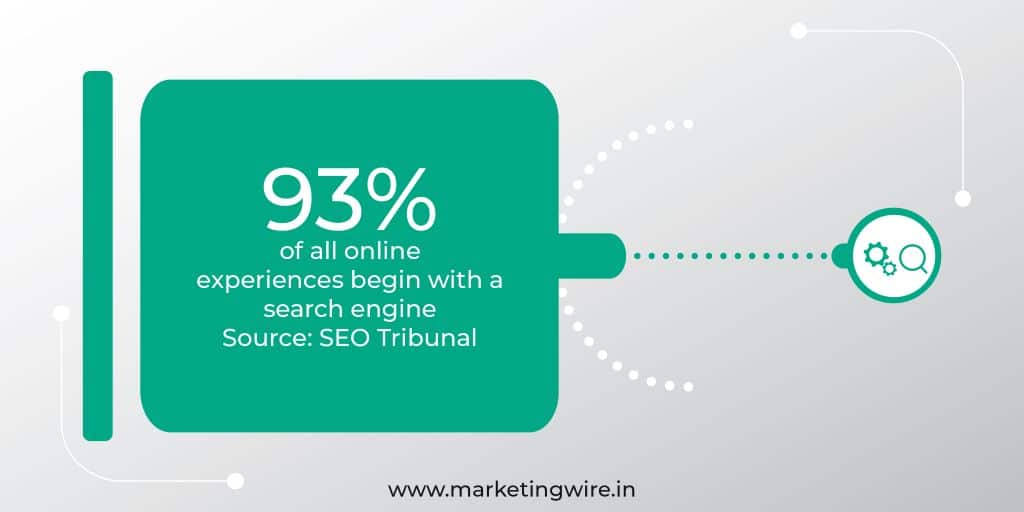
Image Source: Marketing Wire
Search marketing is a driver for the rest of your online marketing strategy, too. They’re the vehicle through which consumers find your brand in other places (like your website or on social media).
Your search marketing strategy needs to include two main search engine optimization (SEO) components:
- On-site SEO – Elements of your own website, such as site structure, meta data, HTML, and content.
- Off-site SEO – External elements that impact your Google rankings, like backlinks, brand awareness, and social signals.
Optimizing for both on-site and off-site factors ensures the highest possible visibility on search engines, where we know that customers are looking for products and brands.
Read more: What is an SEO Marketing Strategy?
Social Media
Consumers love to connect with brands on social media. From targeted ads that show products they’ll love, to influencer marketing, to direct brand interactions — it’s all just as much a part of being on social media as connecting with friends. In fact, recent research from Sprout Social found that 9 out of 10 consumers buy from brands they follow on social media.
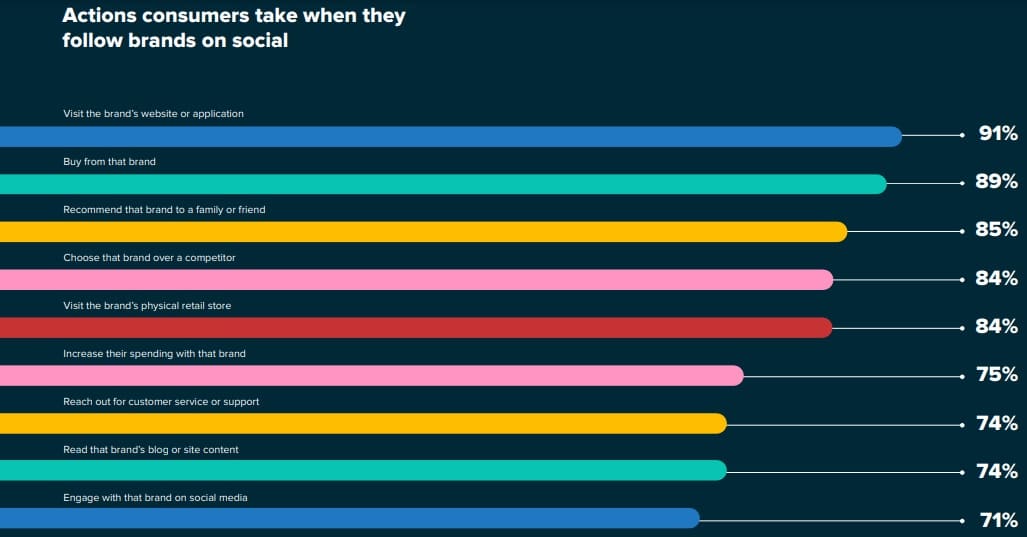
Image Source: Sprout Social
Building a social media presence gives you an opportunity to reach consumers where they already are. Once you’re engaged with your audience on social media, you’re extremely likely to convert them to paying customers.
Read More: A Complete Guide to Social Media-Based Lead Generation
Types of Online Marketing Content
Content types refer to the exact form in which you deliver your content. For example: you may share the same message via written word or video. Top online marketing content types include blog articles, ads, email, video, infographics, and downloadable content. Let’s explore each in more detail.
Blog Articles
Blogs make a huge impact when it comes to online visibility, search rankings, and brand awareness. They’re a way for you to demonstrate expertise on important topics, establish brand awareness, and deliver value to your audience.
On average, websites with blogs earn 434% more indexed pages! They’re viewed at a higher rate and they show up on search engines more often. Blogs are truly the core of a good content marketing strategy.
So how do you write blog articles that are sure to earn traffic and rankings?
The first thing to know is that you’ll need to publish many blog articles over a significant period of time before you’ll see real results. Research shows that brands publishing 11-16+ articles per month earn more than 3x the traffic as those publishing less frequently.
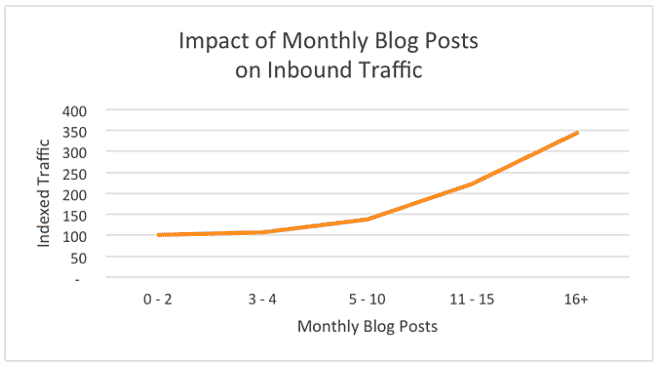
Image Source: HubSpot
Next, you want to choose both pillar topics (those that will serve as the main themes of your blog) and subtopics or niche topics that fall under each pillar topic. Keyword research helps with this process and creating a content calendar where you list article titles and publishing dates can keep you on track. Write articles with your audience in mind, delivering high-value content that builds trust in your brand.
There are different types of blog articles you can write to keep your content varied, including:
- Pillar pieces – These are “ultimate guides” and other long-form, evergreen pieces that comprehensively cover your pillar topics.
- How-to articles – Explain how to solve a problem or accomplish a task.
- List posts – Easy-to-read lists of just about anything (ideas, best products, dos and don’ts, templates, examples — whatever your audience needs).
- News and opinion – Provide commentary on current events or industry trends.
As you write your articles, follow best practices for web writing like concise language, including visuals and CTAs, and of course optimizing for search.
Read More: Your 20-Step Checklist to Write the Perfect Blog Post
PPC Ads
We hear a lot in the marketing world about how organic traffic is best — and in many ways, that’s true. But pay-per-click (PPC) ads on Google and social media platforms are an effective way to attract consumers with high purchase intent.
When used as a complement to organic marketing tactics (like blogging), PPC ads can be a powerful part of your overall online marketing strategy.
Here’s how it works: to launch PPC ads, companies pay the hosting platform (like Google) to display their ads above the organic search results for a particular keyword. Then, they pay per actual click on the ad.
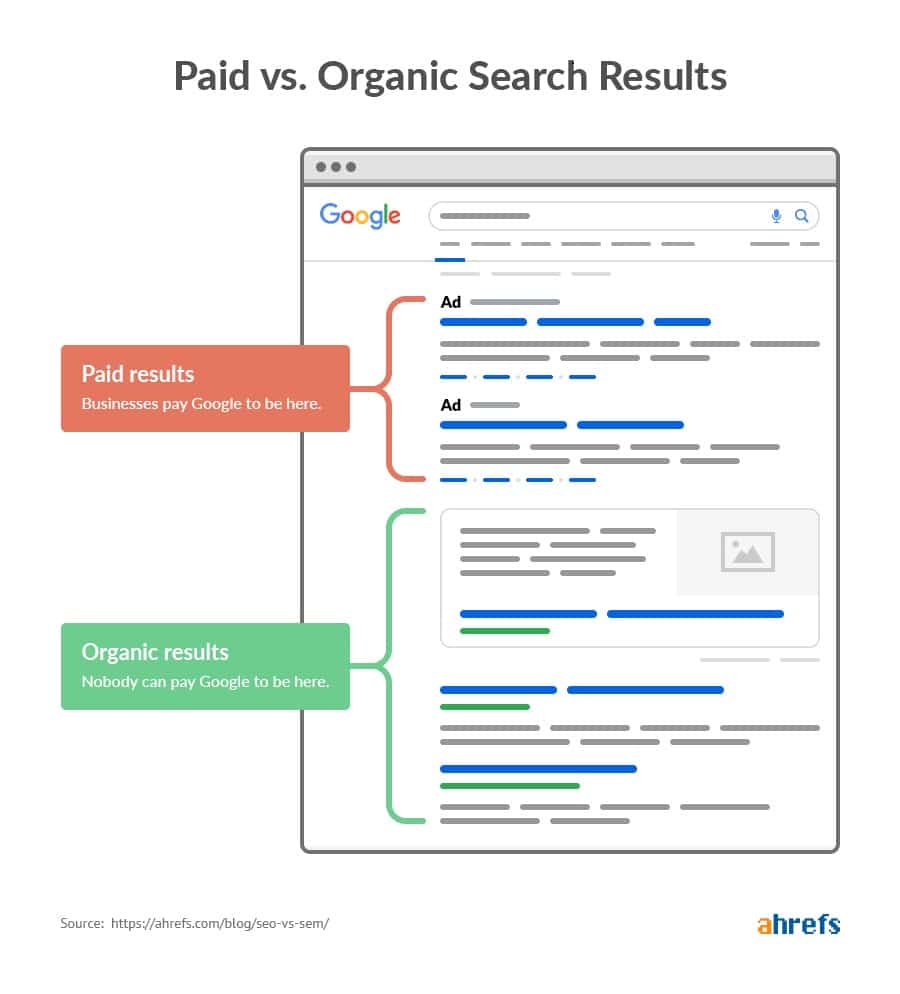
Image Source: Ahrefs
People may scroll past paid ads if they’re in the exploratory phase of their brand research. But many who are ready to buy will click them, and once they do they’re also more likely to convert.
Paid ads are especially useful for targeted campaigns — promoting a certain product, reaching a particular customer segment, hitting high-performing keywords, boosting sales at a certain time of year (and the like). They can give organic traffic a lift and make your brand more visible to people who already know what they need and are likely to buy from the first quality brand they find to provide it.
Read More: 5 Simple Ways Beginners Can Beat the Competition at PPC
We already know email is the most preferred way consumers want brands to reach them, and there are lots of ways you incorporate email into your marketing strategy. The right one depends on your offerings, the goal of your campaign, the customer segment you’re targeting, and the action you want them to take.
Email newsletters are a great way to build ongoing engagement with your audience. They keep your brand consistently visible in their inboxes. They’re also a vehicle for sharing important content like blog articles, promotions, surveys, announcements and more.
Email is also a powerful product promotion tool. It can be used to promote special offers, seasonal deals, and new product launches. B2B companies can use it for cold email outreach and lead nurturing as a way to build their pipelines.
Email marketing platforms have made it easier than ever to automate emails, personalize them with recipient information, and tailor content to their preferences.
The thing to remember about emails is that they have to continually provide high value, otherwise they quickly become inbox junk. Never send an email just to send one — make sure it has a purpose — and always have a good handle on your sending schedule.
Read more: The ROI-Driven Guide to Content for Email Marketing
Video
Demand for video content is on the rise. In fact, Cisco predicts that by the end of this year, video will account for 82% of all web traffic! People are watching short and long-form video from brands, and marketers are taking note.
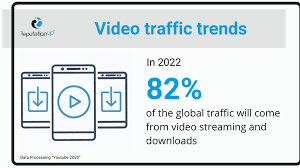
Image Source: ReputationUp
One myth about video content is that you need expertise on how to produce and edit it. Today, this simply isn’t true. Lots of brands shoot their video content with nothing but a smartphone. Social media platforms and other apps make it easier than ever to edit your videos. Much of the time, your videos won’t need any editing at all.
In short: you can make high-quality, low-budget video that your audience will love to watch. Here are some examples:
- Webinars – Educational online events about a particular topic. Brands often feature internal or guest experts to commentate on the topic, or it could be done in the form of an interview.
- Social media stories – A more casual way to share video content and give your audience an authentic, behind-the-scenes view of your brand.
- Vlogs – The video version of blogs, vlogs are used to tell a story or educate on a topic through video.
- Customer success stories – Video is one of the most compelling ways to share stories about your happy customers.
You can also amplify your video content easily by featuring it in blogs, email newsletters, or on your social media sites.
Read more: 8 Exciting Video Marketing Trends for 2022
Social Media Posts
Social media posts can include a variety of content types depending on the platform(s) you’re using. Facebook and LinkedIn, for example, are great to share longer text posts and link to external content (like news or blog articles). Twitter is better for shorter-form text and casual content. Instagram and TikTok have become the places to be for visual content — both video and images.
The great thing about social media posts is that it’s so shareable. People love to share things they find interesting on their own social media pages. If you create social media content that resonates with your customers and industry peers, they will share it for you in other places.
Two other kinds of social media content brands use is influencer content and user-generated content. The former comes from partnerships brands make with influencers who have a following in their target market. The latter is brand content shared by customers and advocates. In both cases, consumers find the content more authentic than traditional brand content.
Finally, social media content can be as simple as amplifying content from other places, like your blog articles or a recent webinar you ran.
Read More: Why Social Media is Important for Business Marketing
Infographics
Infographics are a form of visual content that have become really popular in recent years thanks to their ability to share a lot of information in one place. Brands use infographics to share how-to steps to complete a process, numbers and statistics about a topic, or a list of facts. In all cases, the text content is supported by visuals to make it easily digestible.
Infographics are another highly shareable content type — they’re shared 3x more than any other type of visual content! See below for one of our own examples from Marketing Insider Group; we created a 20-step checklist for building the perfect blog post.
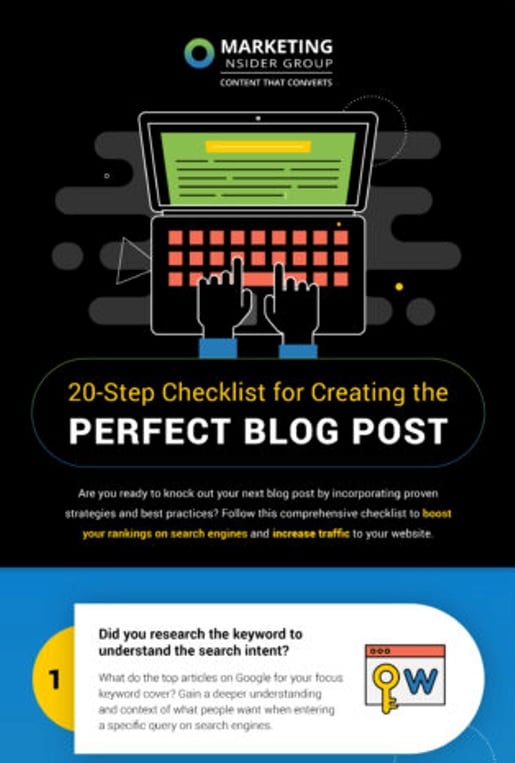
Image Source: Marketing Insider Group
Read More: 20 Super-Awesome Infographics to Inspire Your Content Marketing
Ebooks, Whitepapers, and Reports
Ebooks, whitepapers, and reports are typically offered as downloadable lead magnet content in exchange for a user’s contact information. All three demonstrate brand expertise, but in slightly different ways.
Ebooks are written for more general audiences and serve as introductory guides to a topic or strategy. Whitepapers are more academic — they are usually longer and provide a deeper level of information to a niche, expert audience. Reports are useful to both general and expert audiences, presenting original research on industry trends.
These types of content are especially useful for B2B companies as online lead generators.
Read more: 9 Examples of Ebooks that Convert Like Crazy
How to Market Your Business Online: Build Your Strategy in 8 Steps
Before we dive in here, let’s do a quick recap.
First, we know that marketing your business online is important because people are using the internet to find brands and products. We know that there are four main channels brands can use online to reach customers: company website, email, search engines, and social media.
We also know about the many content types that are effective for engaging audiences, like blogs, emails, ads, video, social media posts, infographics, ebooks, whitepapers, and more.
But the question remains: how do you market your business online? Where do you actually get started to build a strategy that works? And how do you execute?
That’s what we’re going to cover in this section. By following the 8 steps below, you’ll be ready to launch an online marketing strategy that delivers big results for your business.
Define Your Target Audience
Who are your customers? This is the first question you should ask as you build a new online marketing strategy. Brands with an established strategy should still ask it periodically to refine their target audiences based on buyer data.
Knowing who you’re marketing to before you decide on the “what” and “how” enables you to build a strategy that’s both accurately targeted and highly relevant to potential customers. Many brands use the buyer personas to determine their different customer segments and the traits of their buyers.
Most importantly, the buyer persona framework helps determine what buyers are trying to achieve with their purchase. It helps you craft high-value content and messaging based on their pain points and needs.
Read more: Personas are Great (Except When They Suck)
Build Your Brand Voice and Personality
Next, you want to determine your brand voice and personality. Brand voice refers to the way you say things in your messaging. Over time, your voice contributes to your brand personality, or the way people perceive your brand through your marketing content.
You already know your target customers, so you want to build a brand voice and personality that will resonate with them. You also want to be sure it’s consistent across channels, content types, and campaigns.
To accomplish this, it’s helpful to create written guidelines your marketing team can follow to stay true to your brand voice. Start by thinking about traits that describe your brand, then fleshing out how those traits will be presented in your marketing content. A brand voice chart like the one below can be a useful tool:
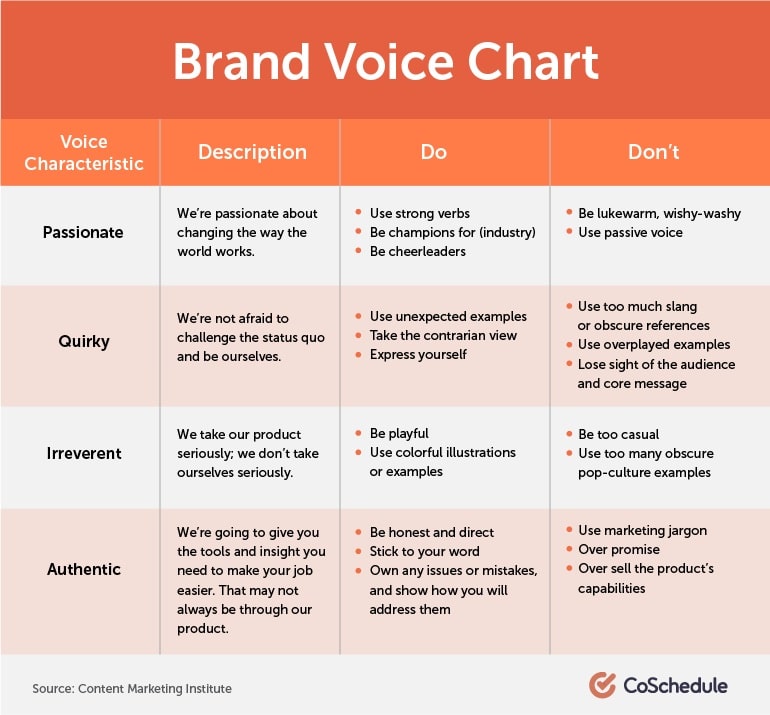
Image Source: CoSchedule
It’s important to note that your brand voice is different from tone. Your tone may vary depending on the message, occasion, and context. Your brand voice, on the other hand, should always be consistent and reflect the traits most central to your brand.
Read more: How to Create a Voice and Tone Brand Guide in 7 Steps
Create a Budget
Fortunately, marketing your business is extremely cost-effective when compared to traditional offline tactics. But there are still costs involved, and you should determine what yours will be before you launch your online marketing strategy.
Some questions to consider:
- What tools will we use for online marketing and what do they cost? These could include email marketing platforms, social media schedulers, etc.
- What are our website-related costs (host, designer, etc.)?
- Will we outsource any tasks related to online marketing (PPC, content creation, etc.)?
- Do we need to hire any additional staff to execute our online marketing plan?
- Will we be using PPC ads? What is our campaign plan/budget?
When you account for all of your potential costs ahead of time, you’re able to prioritize intentionally and execute well on the parts of your strategy that earn the highest ROI.
Read More: This Amount is All the Marketing Budget You Need
Decide on Your Marketing Channels
Brands use multiple channels to market their businesses online. But that doesn’t mean you have to use every one. Particularly if you’re launching a new online marketing strategy, it’s a good idea to start with a few channels and build on your success over time.
A company website is the most important first channel to establish. Then you may want to add social media platforms, and eventually email and ad campaigns. As you’re able to manage each channel successfully, add more to make your presence bigger.
Read More: How to Identify The Right Digital Marketing Channels for Your Business
Create an Execution Plan
One of the most important pieces of advice I can offer you for marketing your business online is to always document your execution plan. A documented plan provides a central reference point for your team, and it keeps everyone accountable for executing.
The thing about creating a documented plan is that it can feel like a job in itself — and frankly, it is. Maintaining an updated execution plan requires time, commitment, and consistency. But the payoff is also high. Marketers using documented execution plans report that their teams are more aligned and focused, they’re better able to identify valuable metrics, and they have better accountability (among other benefits).
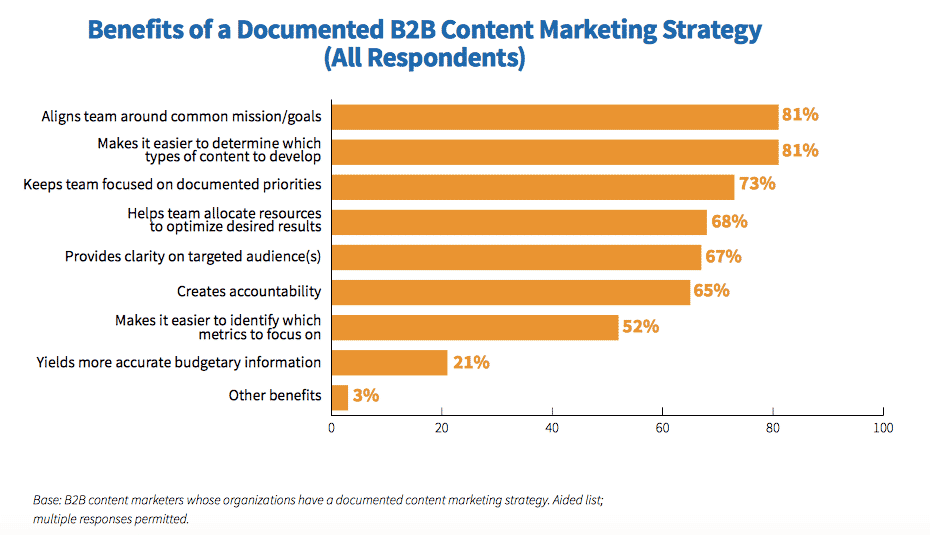
Image Source: Content Marketing Institute
Fortunately, there are plenty of free online templates you can use to help you begin building your strategy. It can be as simple as a shared Google sheet — the important thing is that it’s actually used and continually updated.
Read More: The Big Fat Collection of Content Marketing Templates
Determine How You’ll Measure Performance
To best understand what’s working (and what’s not) in your online marketing strategy, you want to continually measure its performance. To do it, you need to identify your key performance indicators (KPIs). These can include things like organic traffic, rankings, click-through rates, leads generated, email subscribers, and more.
You can use these metrics to determine which tactics are yielding high ROI and which need improvement. You can capitalize on opportunities and pull back from strategies that just aren’t working. Continual performance evaluation also helps you keep your teams motivated and goal-focused.
Once you know which KPIs you’ll use to measure your strategy, create a formalized process for measuring them to make sure you actually do it. Include how often it will happen, who will do it, and how the results will be shared.
Read More: How to Define Digital Marketing KPIs That Align with Your Business Goals
Stay Flexible and Customer-Focused
When it comes to knowing how to market your business online, there’s no single or permanent right answer. For the best results, stick to best practices while remaining flexible about the details. Pay attention to audience and customer behavior. Adjust to changing trends. Use your KPI data to make informed decisions about new strategies.
Companies that adapt and innovate according to what their customers want and what their industry demands will see the most success in the long run.
Over to You
Ready to launch an online marketing strategy that wins? To do it, you’ll need consistently great content. The team of writers and SEO experts at Marketing Insider Group can deliver you optimized, ready-to-publish content every week for one year (or more)!
Check out our SEO Blog Writing Service to learn more or schedule a quick consultation with me to get started.

